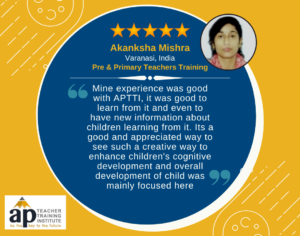Key to Pre-Primary Student Success
Pre-primary teacher training plays an important role in student development, but the quality of the teacher plays a significant role in their learning experience. Therefore by understanding how teacher training can affect a student’s learning, we can identify best practices for ensuring high-quality pre-primary education for all children. In this blog, we’ll explore how one can get pre-primary teacher training certified, the different types of training available, and their benefits in improving student outcomes.
What is the importance of pre-primary education and the role of teacher training?
A pre-primary teacher training course is essential for aspiring Montessori teachers as it provides classroom teaching and child-handling training. The course covers a range of topics that are beneficial for both preliminary and primary school teachers. It equips teachers with the teaching methodologies to guide their students toward reaching their maximum potential. Further, pre-primary teacher training course fees are also affordable. Parents often aspire to establish their children as unique individuals. They often overlook the importance of dedicated and trained pre-primary teachers from teacher training institutes when admitting their children to preschools. This is where the significance of a pre-teacher training course comes in, as it results in offering more professionally skilled preschool teachers. This, in turn, ensures that children receive the maximum benefit from their pre-primary education, as confirmed by elementary school teachers.
What is the impact of teacher training on student learning outcomes in pre-primary education?
Teacher training has a significant impact on student learning outcomes in pre-primary education. This is backed by studies showing that teachers receiving quality training are better equipped to create effective learning environments that promote children’s cognitive, social, and emotional development. Further studies show that well-trained teachers can identify and address individual student needs, use age-appropriate teaching methods and materials, and foster positive student relationships. This leads to improved student engagement and academic achievement. Therefore, investing in teacher training is important for improving the quality of pre-primary education and ensuring long-term positive outcomes for young learners.
What are the different types of pre-primary teacher training programs?
- Pre-primary Teacher Education:
Pre-primary education includes Montessori, Kindergarten, Nursery, and Pre-basic courses. The minimum qualification for admission to this teacher training course Pre-Primary is a higher secondary degree, and these courses typically last for one year. However, some institutes offer two-year training programs too.
- Primary Teacher Education:
These courses last for two years, and the minimum requirement for admission is matriculation. However, the recent trend depicts minimum requirement for admission is higher secondary education.
- Secondary Teacher Education:
These include training colleges that provide a one-year course to prepare graduate students for teaching in secondary or higher secondary classes. The program focuses on teaching principles and methodologies and provides graduates with a B. Ed degree upon completion. The minimum requirement for admission into this program is a bachelor’s degree.
- Higher education:
Higher education courses in education are of four types: (i) One-year M.Ed. Course. (ii) Two-year M. in Education (iii) Two-year Ph.D. course after M.Ed./M.A. (Education) (iv) Post-graduate Diploma in some cases after B.Ed.
- Vocational Teachers/Training:
Specialized teacher training courses are available to provide technical subject instruction. A range of institutions offers these courses, and they are designed to train teachers in specific areas of expertise.
What are the benefits of pre-primary teacher training?
- Improved Learning Outcomes for Students
- Better Teaching Techniques and Strategies
- Improved Organization and Planning Skills
- Better knowledge and Insight into the Industry
What are some tips to improve pre-primary teacher training and student learning outcomes?
- To provide quality pre-primary education, it is essential to have comprehensive pre-service training programs that concentrate on effective teaching practices, pedagogy, and child development.
- Teachers must be provided with ongoing professional development opportunities to be updated with best practices.
- Develop strong partnerships between pre-primary teachers, families, and communities to promote student learning.
- Play-based learning is important to motivate and engage young children.
- Provide appropriate learning materials and resources to ensure that pre-primary classrooms are well-equipped.
- Look for areas of improvement to evaluate and monitor teacher performance and student learning outcomes regularly.
- Give priority to the recruitment of qualified teachers, and this can be achieved by providing competitive salaries, benefits, and supportive work environments.
Conclusion
Pre-primary teacher training is important in improving student learning outcomes in pre-primary education. As stated, research shows that well-planned and executed training programs can enhance teachers’ skills and knowledge, leading to better classroom practices and increased student engagement and achievement. Therefore it is essential to invest in online teacher training opportunities for pre-primary teachers to ensure they have the necessary skills and knowledge to support the development of young learners. In short, by focusing on teacher training, one can get high-quality pre-primary education that prepares children for lifelong learning success.






